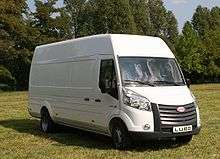Please tell us which country and city you'd like to see the weather in.

FSC Lublin
FSC Lublin was a Polish manufacturer of vans and trucks produced in Lublin by FSC, and derived from Fiat 242/Citroen C35
The production of the Lublin van, which started in 1993, was intended to replace the aging Żuk. It did so in 1998.
The van, known as Lublin 33 was produced until 1995, when Daewoo Motor took control of FSC and renamed it as Lublin II. In 1999 the Lublin III was put into production. After the Daewoo Group bankruptcy, the future of Lublin looked bleak.
In 2001 the brand Lublin was sold to a British company, Truck Alliance. At present the brand is owned by Intrall Polska, a Russo-British company, and the van is sold under the name Intrall.
Some of the Lublin trucks were licensed copies of GAZ vehicles (GAZ-51).
Gallery

Lublin II
Lublin II

Lublin 3Mi after modernization and facelifting in 2005 at Poznań Motor Show
Lublin 3Mi after modernization and facelifting in 2005 at Poznań Motor Show

Intrall Lublin 3Mi
Intrall Lublin 3Mi

New Intrall Lubo was to be launched from the end of 2008

Lublin
Lublin [ˈlublʲin] (Ukrainian: Люблін, Liublin, Yiddish: לובלין Lublin; English pronunciation: /ˈlʌblᵻn/) is the ninth largest city in Poland and the second largest city of Lesser Poland. It is the capital of Lublin Voivodeship (province) with a population of 349,103 (March 2011). Lublin is the largest Polish city east of the Vistula River. Lublin is approximately 170 kilometres (106 miles) southeast of the capital, Warsaw.
Lublin, until the partitions at the end of the 18th century, was a royal city of the Crown Kingdom of Poland. Its delegates and nobles had the right to participate in the Royal Election. In 1578 Lublin was chosen as the seat of the Crown Tribunal, the highest appeal court in the Polish–Lithuanian Commonwealth and for centuries the city has been flourishing as a centre of culture and higher learning, together with Kraków, Warsaw and Lviv.
Lublin was spared from any severe destruction during World War II, which resulted in the preservation of its unique and historical Old Town. The district is one of Poland's official national Historic Monuments (Pomnik historii), as designated May 16, 2007, and tracked by the National Heritage Board of Poland.

Plage i Laśkiewicz
Plage i Laśkiewicz (Plage & Laśkiewicz) was the first Polish aerospace manufacturer, located in Lublin and manufacturing aircraft under Lublin name. Full name was: Zakłady Mechaniczne E. Plage i T. Laśkiewicz - Mechanical Works E. Plage & T. Laśkiewicz. The factory produced aircraft between 1920 and 1935, when it was nationalized as the LWS.
Beginnings and license production
Plage i Laśkiewicz first was a mechanical workshop and steam boiler producer, but in 1920 it started producing aircraft, as the first works in independent Poland. On February 17, 1920, the Polish government ordered a licence production of Italian fighters Ansaldo A.1 Balilla and light bombers Ansaldo A.300 in Plage & Laśkiewicz. The first Polish A.300 was flown on June 14, 1921. However, due to lack of experience, a quality of produced aircraft was low, and there were numerous crashes. As a result, the order was limited to 70 A.300 and 50 A.1 only, produced by 1924.
Despite of unsuccessful beginning, the factory gained experience, and there were no major problems with future aircraft series. In 1924, the Polish government ordered a licence production of French light bombers Potez XV, and in 1925-1926, there were built 100 of them in Plage & Laśkiewicz. In 1928-1931 the works produced 150 of more modern Potez 25. In 1929-1930 the works produced 11 passenger planes Fokker F-VIIb/3m on Fokker licence, and 20 of own Fokker F-VIIb/3m bomber modification.
Lublin (Hasidic dynasty)
Lublin is a Hasidic dynasty founded by Rebbe Yehudo Leib Eiger of Lublin, a town in Poland.
Lineage
Rebbe Yehudo Leib Eiger was a son of Rabbi Shlomo Eiger of Posen, and a grandson of Rabbi Akiva Eger.
See also
References
Radio Stations - Lubelskie
SEARCH FOR RADIOS
Podcasts:

